How to Improve Skin Texture on the Face
Smooth, radiant skin is often viewed as the ultimate beauty goal, with trends like “glass skin” dominating social media platforms. Achieving that flawless complexion, however, can feel elusive for many due to various factors that impact skin texture. If you’ve ever wondered how to improve your skin’s smoothness and get closer to the “glass skin” aesthetic, you’re in the right place. Let’s talk about the common causes of uneven skin texture, the importance of a daily skincare routine, and the best professional treatments to transform your skin.
What Causes Uneven Skin Texture?
Uneven skin texture can result from a variety of underlying issues, and understanding the root cause is the first step to improvement. Here are some of the most common culprits:
-
Milia: These tiny, white, keratin-filled cysts occur when dead skin cells become trapped beneath the skin’s surface. Milia are often found around the eyes and can be stubborn to remove without professional help.
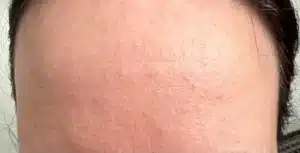
-
Sebaceous Hyperplasia: If you’ve noticed small, yellowish bumps on your skin, it might be sebaceous hyperplasia. This condition happens when sebaceous glands become enlarged, creating bumps that disrupt the smooth surface of your skin.
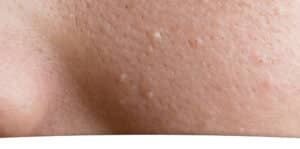
-
Enlarged Pores: Genetics, excess oil production, and clogged pores can all contribute to enlarged pores, which make the skin appear less refined. Those with enlarged pores should focus on fractionated treatments like RF microneedling or fractional laser resurfacing. Any non-fractionated treatment, like Contour TRL, can cause the pores to enlarge further.
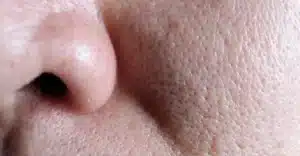
-
Acne Scarring: Whether from cystic acne or persistent breakouts, scars can leave indentations or discoloration that affect the skin’s texture. Acne scarring can be pinpoint or wide and flat. Scarring from acne is a result of inflammation and can leave post-inflammatory hyperpigmentation (PIH) or post-infalmmatory erythema (PIE). When considering treatment, it is important to also treat any browns or pinks left behind from the inflammatory process.
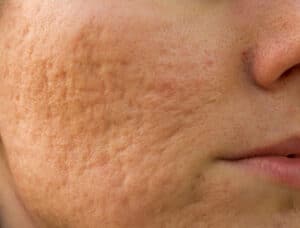
-
Wrinkles and Fine Lines: As we age, our skin loses collagen and elastin, leading to wrinkles that add to an uneven texture. Some wrinkles form as a result of chronic movement of the face, like in the upper face and around the mouth. Wrinkles, or rhytids, can be superficial and fairly easy to treat or very deep and require more aggressive treatments.
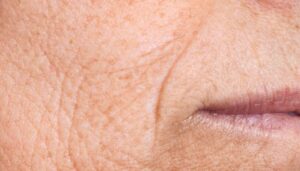
Daily Skincare: The Foundation of Smooth Skin
Let’s face it—achieving great skin texture doesn’t happen overnight. It starts with a consistent daily skincare routine that supports your skin’s natural renewal processes. Here’s what every skincare regimen should include:
1. Cleanse Morning and Night
Cleansing your skin twice a day is crucial. In the morning, it removes oil and sweat that accumulate overnight. In the evening, it clears away makeup, dirt, and pollutants. A gentle cleanser tailored to your skin type ensures your skin is clean without stripping its natural barrier. Cleansers with salicylic acid can be helpful for more oily skin types that tend to form sebaceous hyperplasia. Drier skin types should focus on more gentle cleansers that don’t strip the skin of their natural oils.
2. Apply an Antioxidant Serum in the Morning
Antioxidants like vitamin C can work wonders for skin texture. They neutralize free radicals, promote collagen production, and brighten the skin. Incorporating a high-quality antioxidant serum into your morning routine can help protect your skin and keep it looking smooth and healthy.
3. Use a Retinoid at Night
Retinoids are skincare powerhouses. They increase cell turnover, helping to exfoliate the epidermis and minimize the appearance of wrinkles, acne scars, and uneven patches. Retoinoids build collagen over time to treat and prevent wrinkles. The chemical exfoliation properties of this product help to prevent dead skin cells from clogging pores and forming milia or sebaceous hyperplasia. In addition, retinoids can treat and prevent acne. As you can see, retinoids can treat all causes of uneven skin texture!
If you’re new to retinoids, start with a low concentration and gradually work your way up to avoid irritation. Some formulations are well-tolerated in almost everyone, like SkinBetter Science AlphaRet.
4. Incorporate Exfoliation
Exfoliating products, like Skinbetter Science AlphaRet Exfoliating Peel Pads, can be used several times a week to gently slough off dead skin cells. This step is especially helpful for reducing dullness and keeping pores clear. It’s also helpful in preventing milia and sebaceous hyperplasia.
5. Don’t Forget Sunscreen
Daily sun protection is non-negotiable. UV rays can exacerbate texture issues, from wrinkles to discoloration. A broad-spectrum SPF is your best defense against premature aging and uneven skin tone.
Professional Treatments to Improve Skin Texture
Even with the best skincare routine, sometimes your skin needs a little extra help. Professional treatments can target deeper layers of the skin and tackle stubborn texture concerns. Let’s break down the options:
Low-Downtime Treatments
If you’re looking for noticeable improvements without significant recovery time, these treatments are a great place to start:
-
Chemical Peels: Chemical peels use acids to exfoliate the skin, improving texture by removing dead skin cells and stimulating collagen. Peels come in varying strengths, from superficial to deep, and can be customized to your skin’s needs.
-
Microneedling: Also known as collagen induction therapy, microneedling involves creating tiny injuries in the skin to promote healing and collagen production. It’s an excellent option for smoothing fine lines and shallow scars. Microneedling is especially good for acne scarring and superficial fine lines.
-
Low-Downtime Lasers: Treatments like the NanoLaser Peel and MicroLaser Peel are ideal for maintaining smooth skin with minimal downtime. These lasers target surface irregularities and can provide a noticeable glow after just one session.
Advanced Treatments for Severe Texture Issues
For deeper wrinkles, significant acne scarring, or other pronounced texture problems, more intensive treatments may be required:
-
Halo Laser: This hybrid fractional laser combines ablative and non-ablative wavelengths to treat both surface and deeper layers of the skin. It’s a versatile treatment for texture, tone, and discoloration.
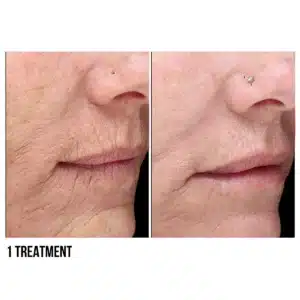
-
Profractional Erbium Laser: This powerful laser resurfaces the skin by creating microscopic channels, stimulating deep collagen remodeling. It’s particularly effective for addressing deeper wrinkles and scars.
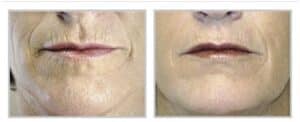
Maintenance Matters: Skincare Beyond Treatments
After investing in professional treatments, maintaining your results is key. Regular visits to a medical aesthetician can help prevent new texture issues from developing. Monthly facials or light chemical peels can keep your skin looking its best and address minor concerns before they become major problems.
Additionally, lifestyle factors like hydration, a balanced diet, and managing stress play a significant role in skin health. Drinking plenty of water, eating antioxidant-rich foods, and getting enough sleep can all contribute to a smoother complexion.
Ready to Transform Your Skin?
If you’re ready to take the next step in improving your skin texture, schedule a consultation with a skincare professional at Saxon MD. Whether you need guidance on building a skincare routine or want to explore advanced treatments, the path to better skin is just a call away. Let’s make glass skin a reality for you!